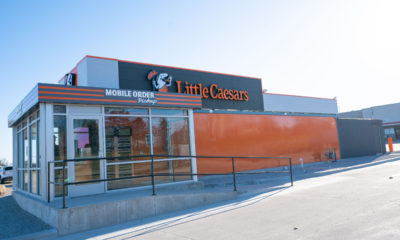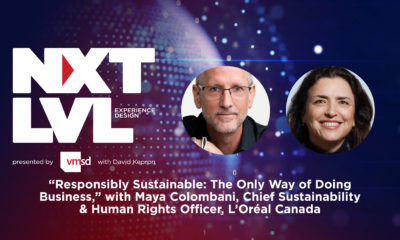ABOUT MARTIN KINGDON:
Martin’s Profile: : linkedin.com/in/martin-kingdon-121b693
Websites:
Email: martin@popai.co.uk
BIO:
Martin has been involved with the display industry for twenty five years as a volunteer, board member and for twenty years Director geneneral
Advertisement
He has been responsible for Insight since 2010, Sustainability since 2019 and has defined POPAI’s offer including setting up the Sustainability council representing all sectors of the industry, the POPAI Sustainability Standard for corporate accreditation and the Sustain® global eco-design indicator tool now widely used in the UK and overseas.
He has spoken extensively around the world on many aspects of the display market, sustainability and shopper insight.
SHOW INTRO:
Welcome to the NXTLVL Experience Design podcast. Over our 4 seasons we have focused on “Dialogues on DATA: Design Architecture, Technology and the Arts”.
NXTLVL features provocateurs for whom disruption and transformation are a way of engaging in work and play every day.
They include leading scientists, artists, musicians, architects, entertainers and story tellers whose research, exploration and built work brings new understanding of the impact and relevance of place-making to the world.
Advertisement
On the show, we focus on what’s now and what’s next.
On this episode we talk with Martin Kingdon Insight and Sustainability Director of POPAI UK and Ireland about the impact that retail stores, and all of their merchandising units and displays, have of on the environment.
First though, a few thoughts on retail, building sustainably and the carbon footprint of stores…
* * * * * * *
On your last shopping trip, to any retailer, what do you remember most?
Was it the crowd or the sales associates?
Advertisement
That you could, or couldn’t, find what you were looking for?
If you were walking the aisle of your favorite grocer, you might recall the product displays, how fantastically the apples were built into a pyramid, the water being misted across the fresh produce crisp keeping it crisp. The meat counters or the smell of bread being baked.
You might have even thought, why on earth they keep putting the milk at the far back corner, but then you’d probably be savvy enough to know that’s a ploy to exposed you to as much merchandise as they can as you go on your dairy search and rescue mission.
If you were shopping your favorite apparel store you might noticed that the mannequins were decked out in new outfits, that some new colorful tops were on the table just after you entered or that those big tables always seemed to be a constant state of disarray with sales associates busying over them putting things in neat stacks to be upended by customers a moment later.
You might notice signage, or the lack of it, when you are trying to find something.
You might remark about the lighting, paint colors, a pattern on the floor and perhaps some architectural element.
Chances are, that you probably don’t recall, in any detail, the things the stuff was sitting on, hanging from or enclosed in. Those things often slip into the background, receding away from your conscious awareness.
And that would also be by design.
My first boss in the retail world at New Vision Studios in New York, the late Joe Weishar, would remind be that the merchandise was the star of the show and all the rest of what was in the store were merely supporting actors or scenery.
Merchandise was king, or queen, or maybe prince or princess.
And, all of that scenery, all of those supporting actors come at a cost.
The architecture, store fixtures hanging racks, shelving, displays, refrigerated cases, signage, coat hooks in fitting rooms along with the chairs or benches, floor tiles, wallcoverings, lighting, checkout counters and cash registers…all of it…comes at a cost.
Not just the cost of designing, prototyping, manufacturing, shipping, installing, repairing or replacing in terms of dollars, but the cost of what all of it adds to our world in terms of carbon.
The amount of carbon generated and released into the environment from the making of that store you love to shop in, is staggering.
The built environment in general is a major contributor of greenhouse gas emissions and therefore a major contributor to the global climate crisis.
By some reports, the built environment generates 40% of annual global CO2 emissions.
Of those total emissions, building operations are responsible for 27% annually, while building and infrastructure materials and construction (typically referred to as embodied carbon) are responsible for an additional 13% annually.
So, when you amble around in your favorite retailer, look again, beyond the stuff, at the environment, and all of those supporting actors, and try to imagine how much embodied carbon is in that one store.
Every element that allows you to shop for all the stuff you remove from the store, stays in the store and has contributed to the global climate crises.
According to Architecture2030.org, the global building stock is set to double by 2060.
And they say, “To accommodate the largest wave of building growth in human history, from 2020 to 2060, we expect to add about 2.6 trillion ft2(240 billion m2) of new floor area to the global building stock,the equivalent of adding an entire New York City to the world, every month, for 40 years.”
Now… if you have ever been to New York, think about how many stores are in that city. Manhattan and the surrounding boroughs of Staten Island, the Bronx, Queens and Brooklyn have a combined area of approximately 370 million square feet of retail stores. (https://www.statista.com/statistics/1011185/total-retail-space-nyc-by-borough/)
According to the New York State Comptroller – “Before the pandemic, the retail sector in New York City accounted for32,600 establishments, 344,600 private sector jobs and $16 billion in total wages in 2019. Dec 31, 2020”
I’m not sure if you apply the “adding the equivalent of a New York City to the world every month for 40 years…” in terms of buildings, that it follows thatyou are also adding 370 million square feet of retail space to the world every month. I’d like someone to do that math…but …
See the thing here?
Retail is a huge component of the global building footprint and major contributor to the climate issue. And your favorite retailer doesn’t, in most case, have one store. They may have hundreds or maybe even thousands.
Where does all the stuff in stores come from?
Does it arrive in your local grocer or fashion store, sustainably sourced, manufactured and shipped?
How is all of it packaged?
What happens to all of those displays, shelving units, hanging racks and refrigerated cases when the retailer goes out of business or renovates every handful of years?
And what about all of the product that fills the shelves of retail stores? What is their impact on the environment in the total amount of CO2 that the store is responsible for producing every year?
Now… to be fair, according to Barron’s, of the top 100 most sustainable companies in the US right now, there are some retailers who have found themselves on the list.
Namely, # 7 Best Buy (Richfield, Minn.), # 21 Walmart (Bentonville, Ark.), # 27 Kroger (Cincinnati), # 30 Lowe’s (Mooresville, N.C.), # 49 Williams-Sonoma (San Francisco), # 67 Target (Minneapolis).
And… we can’t forget about companies like Patagonia whose commitment to saving the planet has been going on for years before it became either cool or politically correct to do so.
They just do it because, well… it’s the right thing to do and designing something, manufacturing it and putting it out there into the world in the thousands should be done with some accountability for its long-range impact on the global ecology.
And this is where my guest Martin Kingdon comes into retail’s sustainability story.
Martin has been involved with the display industry for twenty-five years as a volunteer and board member.
He is an expert in Shopper Behaviour research, particularly shopper engagement with retail store displays or layouts.
Martins has been the Director General of POPAI leading the UK division of the global trade association for companies involved in the Point of Purchase advertising market. POPAI’s members are drawn from retailers, brands, agencies, POP suppliers, installation companies and other support services.
Today he is the Insights and Sustainability Director for POPAI UK and Ireland. He has been responsible for Insight since 2010, Sustainability since 2019 and has defined POPAI’s offer including setting up the Sustainability council representing all sectors of the industry, the POPAI Sustainability Standard for corporate accreditation and something called Sustain® a global eco-design indicator tool now widely used in the UK and overseas.
I was able to speak with Martin Kingdon at the SHOP Marketplace event in Austin Texas about the impact of building store environments and somethings to consider curtailing retail’s effect on the global climate crisis.
ABOUT DAVID KEPRON:
LinkedIn Profile: linkedin.com/in/david-kepron-9a1582b
Websites:
https://www.davidkepron.com (personal website)
vmsd.com/taxonomy/term/8645 (Blog)
Email: david.kepron@NXTLVLexperiencedesign.com
Twitter: DavidKepron
Personal Instagram: https://www.instagram.com/davidkepron/
NXTLVL Instagram: https://www.instagram.com/nxtlvl_experience_design/
Bio:
David Kepron is a multifaceted creative professional with a deep curiosity to understand ‘why’, ‘what’s now’ and ‘what’s next’. He brings together his background as an architect, artist, educator, author, podcast host and builder to the making of meaningful and empathically-focused, community-centric customer connections at brand experience places around the globe.
David is a former VP – Global Design Strategies at Marriott International. While at Marriott, his focus was on the creation of compelling customer experiences within Marriott’s “Premium Distinctive” segment which included: Westin, Renaissance, Le Meridien, Autograph Collection, Tribute Portfolio, Design Hotels and Gaylord hotels.
In 2020 Kepron founded NXTLVL Experience Design, a strategy and design consultancy, where he combines his multidisciplinary approach to the creation of relevant brand engagements with his passion for social and cultural anthropology, neuroscience and emerging digital technologies.
As a frequently requested international speaker at corporate events and international conferences focusing on CX, digital transformation, retail, hospitality, emerging technology, David shares his expertise on subjects ranging from consumer behaviors and trends, brain science and buying behavior, store design and visual merchandising, hotel design and strategy as well as creativity and innovation. In his talks, David shares visionary ideas on how brand strategy, brain science and emerging technologies are changing guest expectations about relationships they want to have with brands and how companies can remain relevant in a digitally enabled marketplace.
David currently shares his experience and insight on various industry boards including: VMSD magazine’s Editorial Advisory Board, the Interactive Customer Experience Association, Sign Research Foundation’s Program Committee as well as the Center For Retail Transformation at George Mason University.
He has held teaching positions at New York’s Fashion Institute of Technology (F.I.T.), the Department of Architecture & Interior Design of Drexel University in Philadelphia, the Laboratory Institute of Merchandising (L.I.M.) in New York, the International Academy of Merchandising and Design in Montreal and he served as the Director of the Visual Merchandising Department at LaSalle International Fashion School (L.I.F.S.) in Singapore.
In 2014 Kepron published his first book titled: “Retail (r)Evolution: Why Creating Right-Brain Stores Will Shape the Future of Shopping in a Digitally Driven World” and he is currently working on his second book to be published soon. David also writes a popular blog called “Brain Food” which is published monthly on vmsd.com.
************************************************************************************************************************************
The next level experience design podcast is presented by VMSD magazine and Smartwork Media. It is hosted and executive produced by David Kepron. Our original music and audio production by Kano Sound.
The content of this podcast is copyright to David Kepron and NXTLVL Experience Design. Any publication or rebroadcast of the content is prohibited without the expressed written consent of David Kepron and NXTLVL Experience Design.
Make sure to tune in for more NXTLVL “Dialogues on DATA: Design Architecture Technology and the Arts” wherever you find your favorite podcasts and make sure to visit vmsd.com and look for the tab for the NXTLVL Experience Design podcast there too.

 Headlines1 week ago
Headlines1 week ago
 Headlines1 week ago
Headlines1 week ago
 Headlines1 week ago
Headlines1 week ago
 Designer Dozen2 weeks ago
Designer Dozen2 weeks ago
 Headlines2 weeks ago
Headlines2 weeks ago
 Headlines5 days ago
Headlines5 days ago
 Headlines2 weeks ago
Headlines2 weeks ago


















